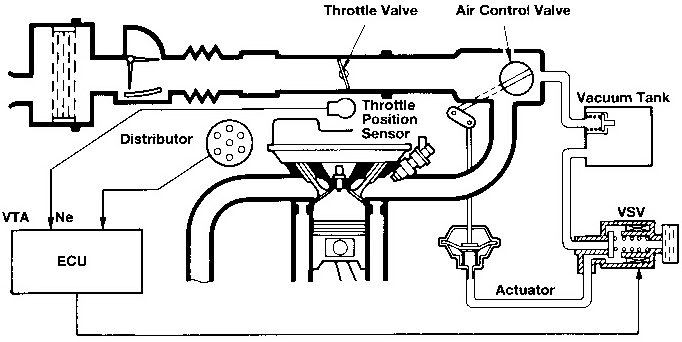In modern vehicles, the throttle position sensor (TPS) plays a significant role in engine performance and fuel efficiency. It monitors and transmits the position of the throttle valve to the engine control unit (ECU). By accurately detecting the position of the throttle, the TPS helps regulate the amount of air entering the engine, thereby controlling the fuel-to-air ratio. This information allows the ECU to adjust fuel injection, ignition timing, and other parameters for optimal engine operation. So, needless to say, the TPS is vital for ensuring smooth acceleration, efficient fuel consumption, and overall vehicle performance.

If you want to have a detailed idea about what the throttle position sensor is and the symptoms of a bad throttle position sensor, today’s post will be helpful. Let’s have a look.
Understanding Throttle Position Sensor (TPS) Operation:
The TPS is a critical component in modern vehicles’ engine control systems. Let’s have a brief overview of its operation process:
TPS Location and Connection to the Throttle Body:
The TPS is typically located on the throttle body, which regulates the airflow into the engine. It is connected to the throttle shaft and directly measures the position of the throttle valve. This connection allows the TPS to accurately monitor the throttle opening, providing valuable information to the engine control unit (ECU) for precise control of fuel injection, ignition timing, and other engine parameters.
TPS Working Principle and Throttle Position Monitoring:
The TPS operates based on a potentiometer or a non-contacting Hall effect sensor. As the throttle valve opens or closes, the TPS detects the corresponding movement and converts it into an electrical signal. This signal is then sent to the ECU, which interprets the data to determine the throttle position. The TPS provides real-time feedback on throttle changes, allowing the ECU to adjust engine performance accordingly.
Role of TPS in the Electronic Control System:
The TPS serves a vital role in the electronic control system of modern vehicles. By continuously monitoring the throttle position, it helps the ECU optimize engine performance, fuel efficiency, and emissions. The TPS data enables the ECU to calculate the appropriate fuel-to-air ratio, adjust ignition timing, and control various engine functions. The TPS’s accurate feedback ensures smooth acceleration, responsiveness, and overall driving experience.
Common Symptoms of a Bad Throttle Position Sensor:
Have you ever thought of what happens when a throttle position sensor goes bad? A malfunctioning throttle position sensor (TPS) can cause various issues in a vehicle’s performance and drivability. Let’s have a look at some of the faulty throttle position sensor symptoms:

- Erratic or Fluctuating Engine Idling: One common symptom of a faulty TPS is an erratic or fluctuating engine idling. The engine may idle at inconsistent speeds or experience sudden fluctuations in RPM. This can result in a rough idle or even cause the engine to stall if the TPS fails to provide accurate throttle position data to the engine control unit (ECU).
- Stalling or Hesitation During Acceleration: A bad TPS can cause stalling or hesitation during acceleration. When the sensor fails to detect the correct throttle position, it disrupts the fuel-to-air ratio and ignition timing. This can lead to engine hesitation or even sudden stalling, as the ECU struggles to adjust fuel injection and timing based on inaccurate TPS readings.
- Sudden Loss of Power or Poor Throttle Response: A malfunctioning TPS can result in a sudden loss of power or poor throttle response. If the sensor provides incorrect or inconsistent throttle position data, the ECU may not supply the appropriate amount of fuel. It leads to decreased engine performance. This can manifest as sluggish acceleration, reduced power output, or a noticeable lack of responsiveness when pressing the accelerator.
- Difficulty Maintaining a Steady Speed: When the TPS is faulty, maintaining a steady speed can become challenging. Inaccurate readings from the sensor can cause the ECU to make incorrect adjustments to fuel delivery, As a result, speed fluctuations occur. The vehicle may experience surges or deceleration without driver input, making it difficult to maintain a consistent speed, especially on highways or during cruise control operations.
Causes of Throttle Position Sensor Failure:
Throttle position sensor (TPS) failure can occur due to various factors, affecting its accuracy and performance.
- Wear and Tear due to High Mileage or Age: Over time, the TPS can experience wear and tear due to the continuous movement of the throttle valve. High mileage or age can lead to the degradation of internal components, resulting in inaccurate readings or complete failure. The constant friction and strain on the TPS can cause its electrical components to wear out, compromising its functionality.
- Exposure to Contaminants and Dirt: The TPS is exposed to the elements and can accumulate dirt, oil, or other contaminants. These substances can interfere with the sensor’s proper operation, affecting its ability to provide accurate readings. Contaminants can lead to sensor malfunction or cause it to provide inconsistent or erroneous throttle position data to the engine control unit (ECU).
- Electrical or Wiring Issues: Loose connections, damaged wiring, or corrosion can disrupt the signal transmission between the TPS and the ECU. Inconsistent or interrupted electrical signals can result in inaccurate throttle position readings, causing engine performance issues or even triggering warning lights on the vehicle dashboard.
- Malfunctioning Throttle Body: If the throttle body becomes stuck, dirty, or damaged, it can restrict the movement of the throttle valve. This limitation can affect the TPS’s ability to accurately detect the position of the throttle, resulting in erroneous readings. A faulty throttle body can ultimately impact the overall performance of the TPS.
Diagnosing a Faulty Throttle Position Sensor:
When experiencing issues with engine performance, diagnosing a faulty throttle position sensor (TPS) can help pinpoint the problem. Here are a few ways to do the diagnosis:
- Using a Diagnostic Scanner or Code Reader: A diagnostic scanner or code reader can retrieve error codes stored in the vehicle’s engine control unit (ECU). If the TPS is malfunctioning, the scanner may indicate specific fault codes related to the sensor. Therefore you will receive valuable information for diagnosis and repair.
- Performing Voltage and Resistance Tests on the TPS: Use a digital multimeter to test a TPS for its proper voltage output and resistance values at different throttle positions. Deviations from the expected readings may indicate a faulty TPS that requires replacement.
- Inspecting the Physical Condition and Wiring of the Sensor: A visual examination can reveal signs of damage, corrosion, or loose connections. Damaged wiring or a worn-out sensor may require repair or replacement. Additionally, checking for any loose or disconnected wires is essential to ensure proper signal transmission between the TPS and the ECU.
The above-mentioned diagnostic steps serve as general guidelines. Consult a professional mechanic or refer to the vehicle’s specific diagnostic procedures for accurate diagnosis and repair.
Repairing or Replacing a Bad Throttle Position Sensor:
When dealing with a malfunctioning throttle position sensor (TPS), several repair and replacement options can be considered.
- Cleaning the TPS and Throttle Body: Clean the components using a throttle body cleaner and a soft brush. Remove built-up dirt and contaminants to improve the TPS’s accuracy and eliminate erratic readings.
- Adjusting or Calibrating the Sensor: This involves following specific procedures outlined in the vehicle’s service manual or using specialized diagnostic equipment. It ensures TPS’s accurate readings and operates within the manufacturer’s specified parameters.
- Replacing the TPS with a New One: If the TPS is severely damaged, worn out, or unable to be repaired, replace it with a new sensor. This involves disconnecting the old TPS, removing it from the throttle body, and installing the replacement sensor. Use an appropriate replacement part that matches the vehicle’s make, model, and specifications.
- Resetting the Engine Control Unit (ECU): After repairing or replacing the TPS, resetting the ECU can help ensure proper communication and synchronization between the sensor and the ECU. Disconnect the vehicle’s battery for a few minutes or use a scan tool to clear any stored error codes. Reset the ECU to optimize engine performance.
You should also consult the vehicle’s service manual or seek professional assistance.
Preventive Maintenance for Throttle Position Sensor:
Implementing preventive maintenance measures can help prolong the lifespan and performance of the throttle position sensor (TPS).
- Regular Cleaning and Inspection of the Throttle Body: Routine cleaning of the throttle body can prevent the buildup of dirt and contaminants that can affect the TPS’s functionality. Use a throttle body cleaner and a soft brush to remove any deposits. Additionally, inspect the throttle body for signs of damage, corrosion, or sticking components.
- Checking and Securing the Wiring Connections: Periodically inspect the wiring connections of the TPS for any signs of wear, damage, or looseness. Secure any loose connections and repair or replace damaged wiring as necessary. Properly functioning wiring ensures a consistent electrical signal between the TPS and the engine control unit (ECU), promoting accurate throttle position data.
- Following the Manufacturer’s Recommended Maintenance Schedule: Adhering to the manufacturer’s recommended maintenance schedule is crucial for overall vehicle health, including the TPS. Regularly servicing the vehicle, including tune-ups and inspections, ensures that components, including the TPS, are in optimal condition.
Implement these preventive maintenance practices and maintain the performance and reliability of the throttle position sensor. It will ensure the smooth operation of your vehicle’s engine and overall driving experience.
Final thoughts,
The throttle position sensor (TPS) plays a crucial role in the modern vehicle’s engine control system. It accurately detects and relays the position of the throttle valve to the engine control unit, allowing for precise fuel-to-air ratio control and optimal engine performance. Addressing TPS issues promptly is essential to maintain vehicle performance, efficiency, and overall driving experience. Take timely action to ensure your vehicle operates at its best and enjoys a smooth and efficient ride.
FAQs:
1. Can you fix a bad throttle position sensor?
A: A bad throttle position sensor (TPS) typically cannot be fixed. It requires replacement with a new sensor.
2. What is the life of a throttle position sensor?
A: The life of a throttle position sensor can vary depending on factors such as usage, maintenance, and environmental conditions. On average, a TPS can last between 50,000 to 100,000 miles.
3. Is the throttle position sensor important?
A: Yes, the throttle position sensor (TPS) is crucial for proper engine performance. It provides real-time feedback on throttle position, allowing the engine control unit (ECU) to adjust fuel injection, ignition timing, and other parameters for optimal efficiency and overall vehicle performance.
